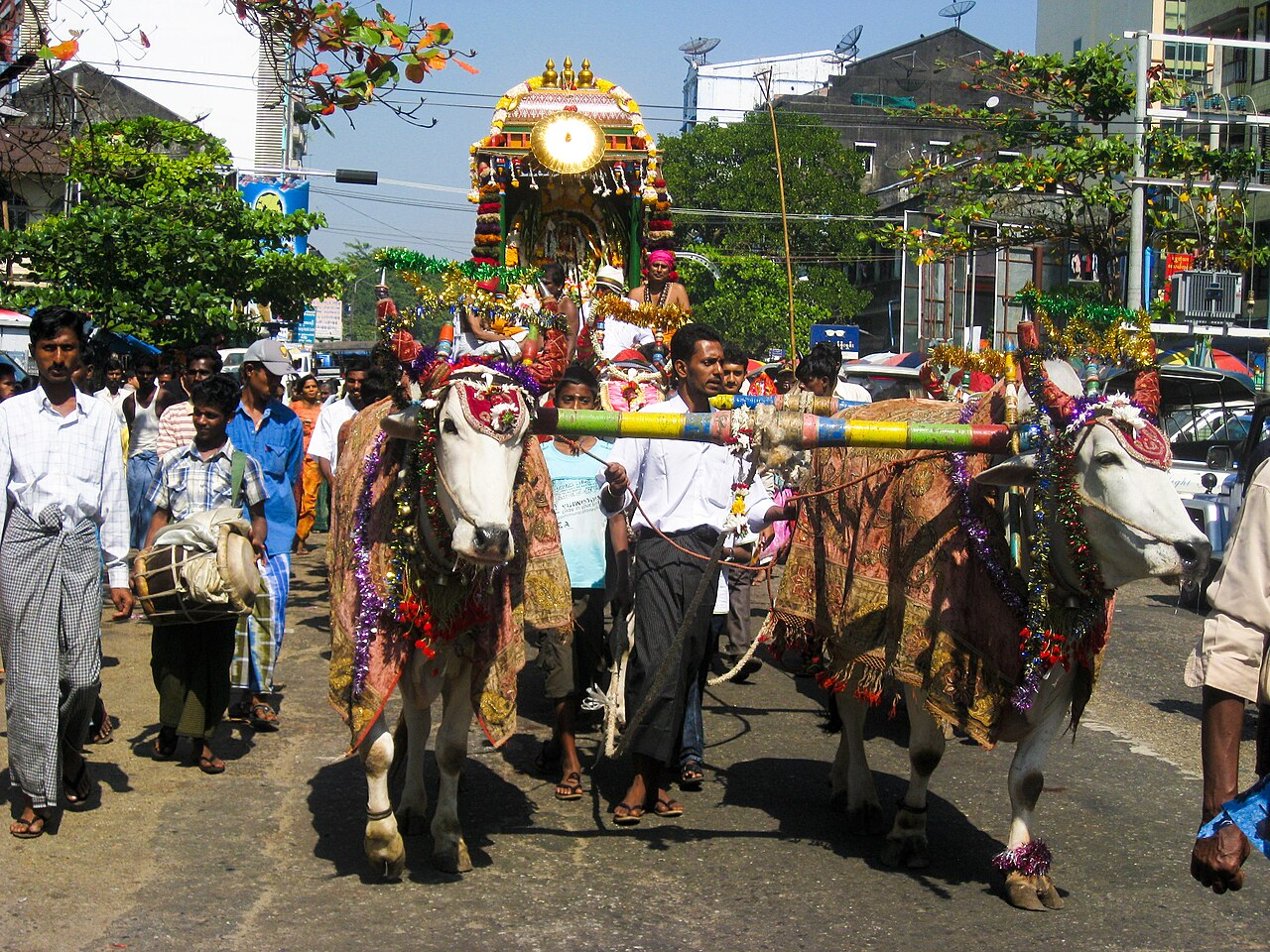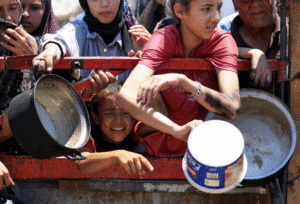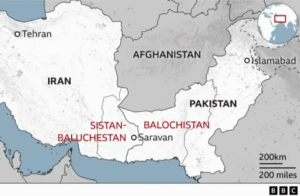Indian influence on Myanmar language, culture and dance
မြန်မာရာဇဝင်လာ သမိုင်းဝင် အိန္ဒိယလူမျိုးများ (၁)
အိန္ဒိယလူမျိုး များဟာ လွန်ခဲ့သော နှစ်ပေါင်း(၂၀၀၀)ကျော်ကပင် မြန်မာ့မြေပေါ် စတင်အခြေချ ခဲ့ကြပြီး မြန်မာနိုင်ငံ၏ နိုင်ငံရေး၊ ဘာသာရေး၊ လူမှုရေး၊ ယဉ်ကျေးမှု ဓလေ့ထုံးစံများကို အားဖြည့် လွှမ်းမိုးခဲ့နိုင်ကြပါသည်။
(စာညွှန်း (၁) မြန်မာနိုင်ငံသည် တရုတ် အိန္ဒိယနိုင်ငံကြား အဝေးပြေး လမ်းမကြီးဖြစ်သည်။ “ပုဂံယဉ်ကျေးမှု” စာမျက်နှာ (၄၂)၊ ပါမောက္ခဦးသန်းထွန်း M.A.B.L, D. LIT, Ph.D
စာညွှန်း (၂) ရှေးဟောင်းပျူများ – စာမျက်နှာ (၃ နှင့် ၄)၊ ပါမောက္ခဦးသန်းထွန်း)

ကမ္ဘာပေါ်၌ တရုတ်ပြည်နှင့် အိန္ဒိယနိုင်ငံတို့သည် ရှေးအကျဆုံးသော လူမှုအဖွဲ့အစည်း နှစ်ခုဖြစ်ခဲ့ပြီး ၎င်းနှစ်နိုင်ငံကို ဟိမဝန္တာတောင်တန်းကြီးက ကာဆီးထားသဖြင့် နှစ်နိုင်ငံ ကူးလူးဆက်ဆံရေးမှာ တိုက်ရိုက်ပြုလုပ်ရန် ခက်ခဲလှပါသည်။
သို့သော် ပထဝီသဘောအရ အိန္ဒိယတိုက်ကြီးမှာ အနောက်တောင်မှ အရှေ့မြောက်သို့ ရွေ့လျားပြီး မြန်မာနယ်စပ်၌ တိုက်မိသော ကြောင့် တွန့်ခေါက်တောင်များ ဖြစ်ပေါ်လာပြီး ဟိမဝန္တာတောင်တန်းကြီးမှာ အရှေ့အနောက် ရှိသော်လည်း ၎င်းတောင်တန်းကြီးများ၏ အရှေ့ဘက်ဆုံး တိဘက်ကုန်းပြင်မြင့် မှစ၍ တွန့်ခေါက်တောင်များမှာ မြန်မာပြည်ကိုဖြတ်၍ မြောက်မှတောင် သွယ်တန်းလျက်ရှိပါသည်။

ထို့ကြောင့် တရုတ်နှင့် အိန္ဒိယနိုင်ငံသားတို့ ကူးလူးဆက်ဆံရန် အနှောင့်အယှက် ဖြစ်နေသော ဟိမဝန္တာတောင်မှာ မြန်မာပြည်ထဲသို့ ကွေးဝင်ပြီး နိမ့်ဆင်းသွားသဖြင့် တိဘက်နှင့် ယူနန်မှ ရှေးဦးလူများမှာ တောင်ကြားလမ်း၊ မြစ်ချောင်းများအလိုက် လွယ်ကူစွာ မြန်မာပြည်ထဲသို့ ဆင်းသက်လာနိုင်ခြင်း ဖြစ်သည်။

Rivers flowing from China into Burma through the valleys
တဖန် ဟူးကောင်းတောင်ကြားလမ်း၊ အမ်းနှင့်တောင်ကုတ်တောင်ကြားလမ်း များမှတဆင့် တရုတ်-အိန္ဒိယ ရွှေလမ်း-ငွေလမ်း ဖောက်လုပ်ခဲ့ကြပြီး ယနေ့ မြန်မာနိုင်ငံမှာ အိန္ဒိယနှင့် တရုတ်နိုင်ငံတို့ကို ဆက်သွယ်ပေးထားသော သဘာ၀ အဝေးပြေးလမ်းမကြီး အဖြစ်သို့ ရောက်ရှိလာခဲ့ရပါသည်။
(စာညွှန်း 1. “ပုဂံယဉ်ကျေးမှု” စာမျက်နှာ (၄၂)၊ ပါမောက္ခဦးသန်းထွန်း)
2. Sri Ksetra was an important entrepôt between China and India. By Htin Aung, Maung (1967). A History of Burma. New York and London: Cambridge University Press.

ထို့ကြောင့် အိန္ဒိယနှင့် တရုတ်နိုင်ငံမှ ခရီးသွားများ၊ စစ်ပြေးဒုက္ခသည်များ၊ ကုန်သည်ပွဲစားများ၊ ရေကြည်ရာမြက်နုရာ ရွေ့ပြောင်းနေထိုင်သည့် သူများမှာ မြန်မာပြည်အတွင်း၌ တစစ အခြေခံ နေထိုင်လာခဲ့ကြပါသည်။

မြန်မာရာဇဝင်လာ သမိုင်းဝင် အိန္ဒိယလူမျိုးများ (၂)
ပျူလူမျိုးများ
(စာညွှန်း ရှေးဟောင်းပျူများ – စာမျက်နှာ (၃ နှင့် ၄)၊ ပါမောက္ခဦးသန်းထွန်း)
မြန်မာ(ဗမာ) လူမျိုးတို့မှာ ပျူ၊ ကမ်းရံ၊ သက် လူမျိုးတို့ပေါင်းစပ်၍ ဖြစ်ပေါ်လာပြီး ပျူတို့မှာ အင်အားအကောင်းဆုံးနှင့် အဓိက အကျဆုံး လူမျိုးဖြစ်သည်။
ပျူများသည်ပင် အခြေခံလူမျိုး(၃)စုမှ ပေါင်းစပ်ဖြစ်ပေါ်ခြင်း ဖြစ်၏။
(၁) ရှေးဦးလူသားအခြေခံ ပျူများမှာ – ကျောက်ခေတ်၊ ကြေးခေတ် နှင့် သံခေတ်မှ စ၍ အစဉ်အဆက် မြန်မာပြည်တွင် နေထိုင်ခဲ့ကြသူများ။
(၂) အိန္ဒိယနိုင်ငံမှ ရွှေ့ပြောင်းအခြေချလာသော ပျူများ၊ သူတို့က ဟိန္ဒူနှင့် ဗုဒ္ဓဘာသာ သာမက ယဉ်ကျေးမှုနှင့် ဓလေ့ပါသယ်ဆောင်လာသူများ ဖြစ်သည်။
(၃) မြောက်ဘက်မှဆင်းလာသော တိဘက် မြန်မာအနွယ်ဝင်ပျူများ။
ပျူများအခြေချခြင်း
ပျူများသည် မြန်မာနိုင်ငံအတွင်း၌ ဘီစီ(၁၀၀)ခန့် သို့မဟုတ် ၎င်းအလျင်ကပင် အခြေချ နေထိုင်ခဲ့ကြသည်။ ဟန်လင်း ကွတ်ခိုင်၊ သံလွင်မြစ်ကမ်း၊ အရှေ့ဘက်ကမ်းရိုးတန်း၊ မုတ္တမပင်လယ်ကွေ့၊ သံတွဲနှင့် ရိုးမဒေသတို့တွင် စတင်အခြေချကြသည်။
(စာညွှန်း- ပါမောက္ခဦးသန်းထွန်း မြန်မာရာဇဝင်ရုပ်ပြစာအုပ်)
ပျူတို့သည် သရေခေတ္တရာ (ပြည်)၌ အေဒီ ၄-၈ ရာစု၊ မိုင်းမော် ဗိတ္တနိုး (အမှန်က ဗစ်ရှနူးခေါ် ဟိန္ဒူ ဘုရားအမည်) (ခမာများက အေဒီ ၂၁၀-၂၂၅သိမ်)၊ တောင်တွင်းကြီး အေဒီ ၁-၄ ရာစု၊ ဟန်လင်း (ဝက်လက်) အေဒီ ၁-၄ ရာစု၊ ဟန်လင်းကြီး တကောင်း (သပိတ်ကျင်း)၊ waddi (နွားထိုးကြီး)၊ မိုင်းမော်၊ မြစ်သား၊ ဘိန္နက (ပျော်ဘွယ်)နှင့် ဘီးလင်း (မွန်ပြည်နယ်) တို့၌ အခြေချနေထိုင်ခဲ့ကြသည်။
အိန္ဒိယ ဂွပ္ပတား (Gupta) မူကွဲ ပျူစာ
Brahmi Script, Gupta script, Pyu script and Burmese script
ပျူကျောက်စာများကို ပါဠိနှင့် ဂွပ္ပတား မူကွဲ ပျူစာများဖြင့် ရေးသားထားပါသည်။ ပျူများအကြောင်းကို တရုတ်ခရီးသည်နှင့် ကုန်သည်များ၏ ကြေငြာချက်ဟူ၍ တရုတ်ရာဇဝင်များ၌ ရေးသားမှတ်တမ်း တင်ထားပါသည်။
ဗိဿနိုးBrikthano (ဗစ်ရှနူး)
ခမာများက အေဒီ ၂၁၀-၂၂၅တွင် ပျက်စီးပြီး မွန်များဝင်လာပြီး ပန်ထွာနှင့် ရာမညမြို့ အဖြစ် ထူထောင်သည်။ ဗုဒ္ဓဘာသာနှင့် ဟိန္ဒူဘာသာ ကိုးကွယ်ကြသည်။ ဗုဒ္ဓရုပ်တုတော်များနှင့် ဂွပ္ပတား (အိန္ဒိယ)ဟန် ဟိန္ဒူဘုရားရုပ်တု မျိုးစုံကို တွေ့ရှိရသည်။
(Ref: Aung-Thwin, pp. 35–36, Harvey, p. 4)
ပျူဘုရင်များကို မဟာရာဂျာများဟုခေါ်ခြင်း
တရုတ်ရာဇဝင်မှတ်တမ်းများ၌ ပျူများကို “P’ aio” ပအိုဟု မှတ်တမ်းတင်ထားပါသည်။ သို့သော် ပျူတို့ကမူ သူတို့ကိုယ်သူတို့ Tricul တီကျူးဟု သမုတ်ပါသည်။ တရုတ်ရာဇဝင်၌ နန်ချိုရှမ်းတရုတ်များနှင့် တိဘက် ပူးပေါင်း၍ တရုတ်ကို တိုက်ခိုက်ခြင်း မှတ်တမ်းများ တွေ့ရပါသည်။ နန်ချိုရှမ်းတရုတ်ဘုရင် Ko-lo-fan ကိုလိုဖင်၏ ပျူများနှင့် ဆက်သွယ်သော မှတ်တမ်းများလည်း တွေ့ရပါသည်။ ပျူဘုရင်များကို မဟာရာဂျာများ၊ မှူးမတ်ချုပ်များကို MAHSINAS မဟာဒီနားဟု မှတ်တမ်းတင်ထားပါသည်။
ပျူဘုရင်များ VISNU (ဗစ်ရှနူး)ဘွဲ့ ကို အိန္ဒိယ ဂွပ္ပတား (Gupta) ဓလေ့အရ ယူခြင်း
တောင်ပိုင်း အိန္ဒိယ အက္ခရာသုံး၍ မှတ်တမ်းတင်ထားသော ပျူကျောက်စာများ၌ ဗစ်ရာမ (VIKRAM) မင်းဆက်က အေဒီ ၆၇၃မှ ၇၁၈အထိ စိုးစံခဲ့ကြောင်း မှတ်တမ်းတင်ထားပါသည်။
(စာညွှန်း Burma, D.G.E.HALL MA D.LIT, F.R.HIST. Professor Emeritus of the University of London and Former Professor of History, Rangoon, Burma 3rd. Eddition 1960 Page 8.)

ထိုကျောက်စာများ၌ ဗစ်ရာမနောက်မှ ဗစ်ရှနူး (ဟိန္ဒူဘုရား) အမည်များကို တွဲဖက် ဖော်ပြလေ့ ရှိကြသည်။
ဗစ်ရှနူး (ဟိန္ဒူနတ်ဘုရား)က ဂရုဒါ (GARUDA) ခေါ် ဂဠုန်ငှက်ပေါ်၌ မတ်တပ်ရပ်နေပြီး လက်ရှမီး (LAKSHMI ဟိန္ဒူနတ်ဘုရားမ) က ကြာပန်းပေါ်၌ ရပ်နေသော ရုပ်တုများနှင့် ဘရာမာ (BRAHMA ဟိန္ဒူနတ်ဘုရား)၊ ရှီဗာ (SIVA)နှင့် ဗစ်ရှနူး ပလ္လင်များ ကို မြန်မာနိုင်ငံအတွက် ပျူတူးဖေါ်ရာ၌ တွေ့ရှိခဲ့ပါသည်။
ထို့ပြင် ဗာမင် (VAMAN)ဘုရင်မင်းဆက် ရှိခဲ့ပြီး အိန္ဒိယနိုင်ငံ ပလာဗာ (PALAVA)မင်းဆက်၏ လွှမ်းမိုးမှု မကင်းကြောင်း တွေ့ရှိရပါသည်။
(စာညွှန်း Elizabeth Moore, Myanmar Historical Research Journal (2004))
ပန်ထွာရှိ အိန္ဒိယ (DRAVIDIAN) ဒြာဗီဒီယန်နွယ်များ
တရုတ်ရာဇဝင် ချန်ယိစိန်၌ မုတ္တမပင်လယ်ကမ်းခြေ မွန်ဌာနေ၌ ဒြာဗီဒီယန် အိန္ဒိယနွယ်ဖွားများ အခြေချ နေထိုင်ခဲ့ကြောင်း မှတ်တမ်း ပါရှိသည်။
၎င်းတို့သည် ဗိဿနိုးကို ဝင်ရောက်လွှမ်းမိုးပြီး ပန်ထွာအဖြစ် အမည်ပြောင်း တွင်စေခဲ့သည်။ ထိုမှတဖန် ရာမညပူရအဖြစ် ပြောင်းလဲခဲ့သည်။
(စာညွှန်း D G E HALL “BURMA”)
တကောင်းမှာ ဒွတ္တဘောင်၏ မိဘတို့ ပါဝင်သော ဒဏ္ဍာရီပုံပြင်၌ ယှက်နွယ်နေသည့် ဗိဿနိုး ဘုရင်မကြီးနှင့် ဆက်သွယ်မှုမှာ အထောက်အထား မခိုင်လုံလှပေ။ သို့သော် သရေခေတ္တရာ အုပ်ချုပ်သော မင်းများနှင့်မူ ဆက်နွယ်နေ၏။ အဓိကအားဖြင့် ဟိန္ဒူဘုရင်များ၏ အရိုက်အရာ ဆက်နွယ်မှု၊ ဗုဒ္ဓဘာသာ ဂိုဏ်းကွဲများ လွှမ်းမိုးမှုနှင့် ဒဏ္ဍာရီဆန်သော အဖြစ်များ ရောမွှေထားသော သမိုင်းကြောင်း ဖြစ်နေသည်။
Bawbawgyi Pagoda at Sri Ksetra, prototype of Pagan-era pagodas
သမိုင်းဆိုတာ မပျောက်ပါဘူး…..
Creditး AungminKhant

From my Wikipedia article: Burmese Indians
Culture

A Hindu temple procession in Yangon
Credit: onourownpath.com – https://www.flickr.com/photos/bessieandkyle/5554291173/in/photostream/
India has been particularly influential in Burmese culture as the cradle of Buddhism, and ancient Hindu traditions can still be seen in Brahmans presiding over important ceremonies such as weddings and ear-piercings but most notably in Thingyan, the Burmese New Year festival.[29] The Burmese poetry tradition of niti (notably the Dhammaniti) also has Indian origins.[30] Traditions of kingship including coronation ceremonies and formal royal titles as well as those of lawmaking were also Hindu in origin.[29] Many Burmese dishes and breads came as a result of Indian influence, prominently reflected in the Burmese version of Indian biryani.
Burmese Indians came from various groups from different parts of India, including Tamils (majority) and also minority groups such as Telugus, Bengalis, Hindustani speakers, Gujaratis and Punjabis. Today they form approximately 2% (about 950,000)[31] of the population, according to the CIA World Factbook 2006, although exact figures do not exist due to uncertainties over census results and methods in Myanmar. Disaffected young Indians often flee the cities and join ethnic resistance movements. The All Burma Muslim Union whose members consist largely of Muslims of Indian origin is routinely labelled by the government as “Muslim terrorist insurgents“. It operates alongside the Karen National Union which has a militant wing and, despite a swelling of its ranks following anti-Muslim riots in the eighties, remains a very minor force.[32]
Religion
Main articles: Buddhism in Burma and Hinduism in Southeast Asia § Burma
Burmese Indians practise Hinduism, Islam, Sikhism, Buddhism and Christianity. Burmese-Indian Hindus have good and peaceful relationships with the native Burmese.
Predominantly, Burmese Indians are Hindu. The practice of Hinduism among Burmese Indians is also influenced by Buddhism. In addition of Hindu deities, the Buddha is also worshiped and many Hindu temples in Myanmar house statues of the Buddha.[33][34]
Burmese Muslims, some of them of mixed blood born of Burmese mothers and some of them with full Burmese blood, (ဗမာမူစလင်); with small numbers of Twelvers.[35] The Burmese call them Zaydabayi.
The constitution grants limited rights to freedom of religion; however, some articles in the constitution, as well as other laws and policies, restrict those rights. In practice the government enforced those restrictions.[36] “Muslims continue to experience the most severe forms of legal, economic, religious, educational, and social restrictions and discrimination”.[37] The military dictatorship rejects or ignores their requests when they want to build mosques in the country or to go abroad for religious ceremonies.[21][32] Although there is limited freedom of religion in Burma, Muslims decided not to hold Eid al-Adha in 2012 due to Rakhine-Rohingya strikes in Rakhine State.
Languages
Burmese Indians are from an array of linguistic groups, mostly are Tamils from Tamil Nadu. There is also significant population of the Meiteis (Manipuris[38][1][2]), coming from Myanmar’s western neighborhood Manipur state.[39] Other minorities are Telugus from Andhra Pradesh and Marwaris from the Marwar region of India’s Rajasthan state as well as Bengalis hailing from the Indian state of West Bengal as well as the present-day independent nation of Bangladesh. Prior to the expulsion of Indians, there were also Malayalis from Kerala, Odias from Odisha, Punjabis from the state of Punjab who are mostly Sikhs and two groups of Gujaratis, both Gujarati-speaking Parsis and Gujaratis proper who are mostly Hindus or Muslims by faith hailing from the state of Gujarat. All can and were able to communicate in Burmese due to years of assimilation and lack of education in languages other than English. Tamil is the most spoken Indian language in Myanmar. Other minority Indian languages are quite frequently used.








